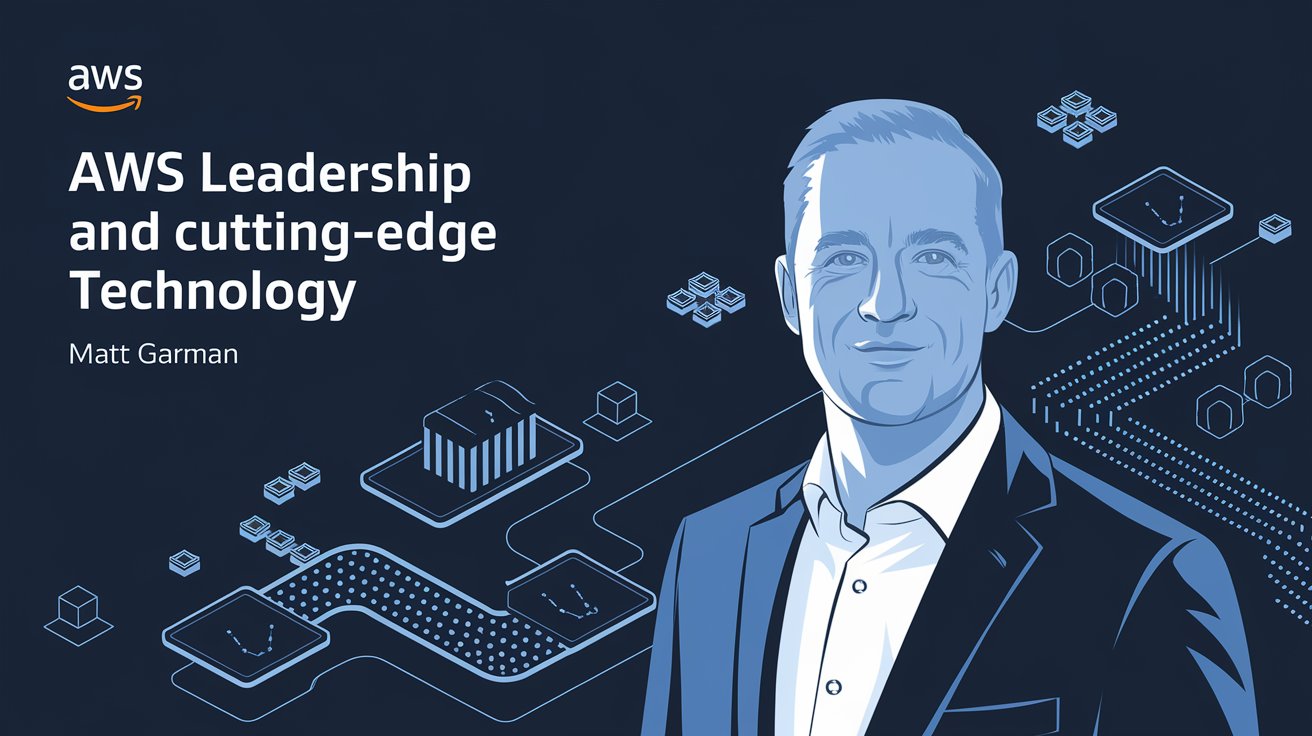Amazon Web Services (AWS), the cloud computing arm of Amazon, has long been a dominant force in the cloud industry, providing scalable computing power, storage, and infrastructure services to businesses of all sizes. As AWS continues to lead in the cloud space, it has been at the forefront of emerging technologies such as generative AI, open-source software, and service optimization, shaping the future of cloud computing. Matt Garman, AWS’s Senior Vice President of Sales, Marketing, and Global Infrastructure, has been a key figure in driving these innovations.
In recent years, Garman has made critical decisions regarding AWS’s strategy, including its approach to generative AI, open-source projects, and its decisions to sunset certain services. In this blog, we will explore Garman’s views on these topics and how AWS is positioning itself to stay ahead in the fast-changing tech landscape.
The Rise of Generative AI in AWS
Generative AI, a subset of artificial intelligence, focuses on creating new data that mirrors the characteristics of the data it was trained on. It has seen an explosion of interest due to its ability to generate content, code, and even art. At the core of this trend are technologies like large language models (LLMs), transformers, and GANs (Generative Adversarial Networks), which have enabled breakthroughs in areas such as natural language processing, image generation, and text-to-speech applications.
AWS has been actively developing and offering tools to support the adoption of generative AI. Garman has highlighted that AWS’s approach focuses on providing developers with the infrastructure they need to train, deploy, and scale AI models. Amazon SageMaker, AWS’s flagship machine learning platform, is central to this effort. It allows developers to build, train, and deploy machine learning models, including those used for generative AI, in a fully managed environment.
Under Garman’s leadership, AWS has introduced features that make it easier for businesses to leverage generative AI for practical applications. For instance, AWS has partnered with OpenAI and other leading AI companies to offer pre-trained models and services that simplify the development of AI-driven applications. These efforts have been instrumental in lowering the barrier to entry for companies looking to use AI to automate processes, generate insights, or enhance customer experiences.
Garman has been particularly vocal about the importance of democratizing AI, making it accessible to businesses without requiring them to invest heavily in custom AI development. He has emphasized that AWS’s goal is to offer flexible, scalable solutions for AI workloads that can be used by organizations of all sizes, from startups to global enterprises.
Open Source at AWS: A Balancing Act
Open-source software has long been a vital part of the tech ecosystem, driving innovation and collaboration across industries. AWS, as the largest cloud provider, has a complex relationship with open-source projects. On one hand, AWS relies on open-source technologies like Linux, Kubernetes, and Docker to power many of its cloud services. On the other hand, AWS has faced criticism from the open-source community for commercializing open-source software without contributing sufficiently back to the projects it profits from.
In response to these criticisms, Matt Garman and other AWS executives have made efforts to increase AWS’s contributions to open-source projects. AWS now actively supports several open-source initiatives, including Firecracker, a microVM open-source project used in serverless computing, and Open Distro for Elasticsearch, an open-source distribution of Elasticsearch.
Garman has emphasized that AWS’s commitment to open source is focused on creating value for developers by enhancing existing projects and offering them as fully managed services. The introduction of services like Amazon RDS for MySQL, Amazon RDS for PostgreSQL, and Amazon Aurora, based on popular open-source databases, is an example of AWS integrating open-source technologies while providing additional scalability, security, and ease of use for its customers.
However, the tension between AWS and the open-source community remains. Some critics argue that AWS’s financial strength gives it an unfair advantage when it takes open-source software and offers it as a commercial service, competing with smaller companies or the original creators of the software. Garman has addressed this by reinforcing AWS’s belief that customers benefit most when they have choices, and AWS aims to provide robust options for those who prefer open-source solutions.
Garman has also discussed the balance AWS strives to maintain between supporting open-source projects and building proprietary services that offer additional functionality or performance benefits. AWS’s approach to open source seems to be evolving, and Garman’s role in shaping this strategy ensures that the company remains a significant player in both the commercial and open-source ecosystems.
Service Rationalization: Scaling Back to Move Forward
As AWS continues to grow its portfolio of services, one of the challenges it faces is managing the vast array of offerings. Over the years, AWS has launched hundreds of services, many of which have become integral to modern cloud infrastructures. However, not every service achieves the level of success or market adoption initially envisioned. Under Garman’s leadership, AWS has started to take a more deliberate approach to evaluating its service offerings, even making the difficult decision to discontinue some underperforming services.
Service rationalization, or “sunsetting,” is a natural part of AWS’s growth strategy. It allows the company to focus resources on its most promising and widely adopted services while discontinuing those that no longer align with its long-term goals. While some customers may view these decisions as disruptive, Garman has explained that they are necessary for AWS to continue innovating and delivering high-value services to its customers.
One example of this is the recent closure of Amazon Alexa Internet, a service that provided web traffic analytics. Once a popular tool for ranking websites, Alexa Internet was discontinued in 2022 as demand waned and alternative analytics platforms became more widely available. Garman described this decision as part of AWS’s broader effort to focus on core services that drive growth and innovation, such as AI, machine learning, and cloud infrastructure.
Another instance of AWS scaling back was the sunsetting of Amazon Cloud Directory, a service for building flexible, hierarchical data structures. While the service had its niche applications, AWS decided to retire it in favor of more versatile and widely adopted solutions like Amazon DynamoDB and Amazon Cognito.
Garman’s approach to service rationalization underscores AWS’s commitment to staying agile in a competitive market. By evaluating customer feedback and usage patterns, AWS can identify which services are delivering value and which are not meeting expectations. This focus on continuous improvement ensures that AWS remains a leader in cloud computing, even if it means retiring services that no longer align with its strategic vision.
The Future of AWS: Innovation and Adaptation
As AWS continues to evolve, Matt Garman’s leadership is critical in guiding the company through a period of rapid change in the cloud and tech industries. With the growing importance of AI, machine learning, and open-source technologies, AWS is positioning itself to remain at the forefront of these innovations.
Generative AI, in particular, is likely to play an increasingly central role in AWS’s future offerings. Garman has made it clear that AWS’s focus will remain on providing the infrastructure and tools necessary to support AI development at scale. This includes expanding Amazon SageMaker and offering pre-trained models that enable businesses to quickly adopt AI without needing to build their models from scratch.
In the open-source arena, AWS’s efforts to contribute more actively to key projects and balance its commercial interests with community collaboration will be critical in shaping its long-term relationships with developers and enterprises. As more organizations adopt open-source software in the cloud, AWS’s role as both a contributor and a platform provider will continue to evolve.
Service rationalization will also remain a key component of AWS’s strategy. By streamlining its offerings and focusing on the services that deliver the most value to customers, AWS can continue to innovate while maintaining the agility needed to stay ahead in the competitive cloud market.
Conclusion
Matt Garman’s leadership at AWS has been marked by a focus on innovation, customer-centric decision-making, and a balanced approach to emerging technologies. Whether through the adoption of generative AI, support for open-source projects, or the strategic sunsetting of services, Garman has guided AWS to remain a leader in cloud computing.
As AWS continues to expand its influence in key areas like AI, open-source software, and cloud infrastructure, Garman’s approach reflects the company’s commitment to staying at the forefront of technological advancements while maintaining a strong focus on customer needs. The future of AWS will undoubtedly be shaped by these priorities, and under Garman’s guidance, the company is well-positioned to meet the challenges and opportunities of the rapidly evolving digital landscape.





